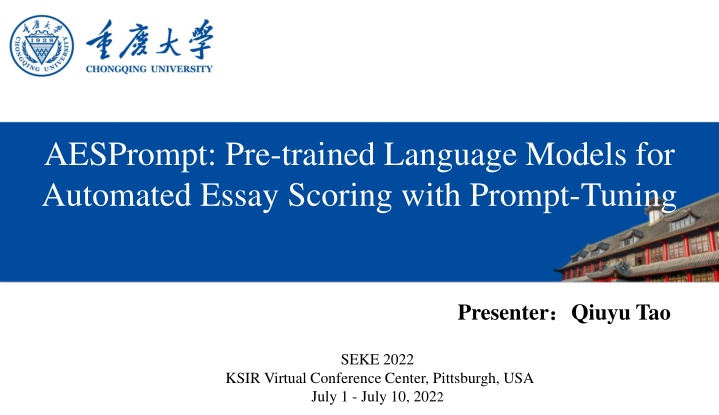
AESPrompt: Pre-Trained Language Models for Automated Essay Scoring
"Learn about AESPrompt, a framework for automated essay scoring using pre-trained language models with prompt tuning. Discover how Prompt Encoder and self-supervised constraints enhance essay quality assessment. Explore the innovative prompt-based tuning method and self-supervised learning techniques for improved document structure awareness."
Download Presentation

Please find below an Image/Link to download the presentation.
The content on the website is provided AS IS for your information and personal use only. It may not be sold, licensed, or shared on other websites without obtaining consent from the author. If you encounter any issues during the download, it is possible that the publisher has removed the file from their server.
You are allowed to download the files provided on this website for personal or commercial use, subject to the condition that they are used lawfully. All files are the property of their respective owners.
The content on the website is provided AS IS for your information and personal use only. It may not be sold, licensed, or shared on other websites without obtaining consent from the author.
E N D
Presentation Transcript
AESPrompt: Pre-trained Language Models for Automated Essay Scoring with Prompt-Tuning Presenter Qiuyu Tao SEKE 2022 KSIR Virtual Conference Center, Pittsburgh, USA July 1 - July 10, 2022
Outline 1 Introduction 2 Method 3 Experiments 4 Conclusion
Introduction Automated essay scoring(AES) aims to automatically assign scores to student essays based on the quality of writing, which is a necessary task in educational applications. Previous approaches have made many attempts with pre-trained BERT for essay scoring and achieved the state-of-the-art. However, these approaches mainly rely on the high storage and computation consumption. Fig 1(a). BERT fine tuning for automated essay scoring
AESPrompt In this section, we introduce our AESPrompt framework, which contains two parts: Prompt Encoder Self-supervised constraints for essay scoring Essay E self-supervised constraints [CLS] I think that Prompt Encoder ... Trainable DIS PRD ... e([CLS]) e(I) e(think) e(that) ... ... ... ... Pre-trained BERT(Frozen) Pre-trained BERT(Frozen) ... Class Label (with linear head) Fig 2. Model architecture of AESPrompt. We design two self-supervised constraints for Prompt Tuning.
Prompt Encoder The prompt-based tuning method is proposed to narrow the gap between downstream and pre-train tasks. We first randomly initialize a multi-layer prompt that prepends a continuous embedding into the input sequence for each layer of the BERT as additional keys ?? ?? ?and values ?? ?? ?to the multi-head self-attention mechanism.
Prompt Tuning with self-supervised constraints To further enhance the prompt s generalization and document structure awareness. we design self-supervised learning with discourse indicator shuffle and paragraph reordering to pre- train our prompts.
Prompt Tuning with self-supervised constraints Discourse Indicator Shuffle Paragraph Reordering Detection Label=1: original essay Label=0: corrupted essay The discourse indicator refers to the conjunction We divide the document into three parts and Computers benefit ... also allow ... Some people ..., and most people... But going to ..., you can ... We instead of learn about their ... DI shuffled, incohesive Computers benefit ... however ... Some people ..., but most people... Instead of going to ..., you can ... We also learn about their ... Computers benefit ... also allow ... Some people ..., most people... But going to ..., you can ... We instead of learn about their ... indicating the relationship between sentences. each part consists of one or more complete To simplify, for one DI token is chosen, 1) we sentences. And then permute them into three randomly replace the token with other DI 60% of possible permutations: the time. 2) delete the DI 20% of the time, 3) P = {(1, 2, 3),(2, 3, 1),(3, 1, 2)} Computers benefit ... and allow ... Some people ..., but most people... Instead of going to ..., you can ... We also learn about their ... Instead of going to ..., you can ... We also learn about their ... Computers benefit ... and allow ... Some people ..., but most people... unchanged the token 20% of the time. Paragraph Reordering, incoherent Fig 3. Proposed self-supervised constraints which utilizing coherent/cohesive and incoherent/incohesive texts for Prompt Tuning
Dataset ASAP (Automated Student Assessment Prize)dataset is provided by a Kaggle competition which contains eight different essay sets written by students from grade 7 to grade 10. Table 1. Details of ASAP Dataset 1https://www.kaggle.com/c/asap-aes/data
Evaluation Quadratic Weighted Kappa (QWK) is the official evaluation metric in the ASAP competition, which measures the agreement between ratings assigned by humans and ratings predicted by AES systems. Table 2.The performance (QWK) of all comparison methods on ASAP dataset. The best measures are in bold. * denotes statistical model
Conclusion We propose AESPrompt, a prompt-tuning framework for the essay scoring task. To the best of our knowledge, this is the first approach to incorporate a prompt-based method for essay scoring. To better optimize the continuous prompts, we propose AES-related self-supervised constraints, including discourse indicator and paragraph order. We conduct experiments on the ASAP dataset with the BERTbase model. Experimental results not only illustrate the effectiveness of AESPrompt in full data settings but also reinforce the stability in low-resource settings.
Thank you ! SEKE 2022 KSIR Virtual Conference Center, Pittsburgh, USA July 1 - July 10, 2022
